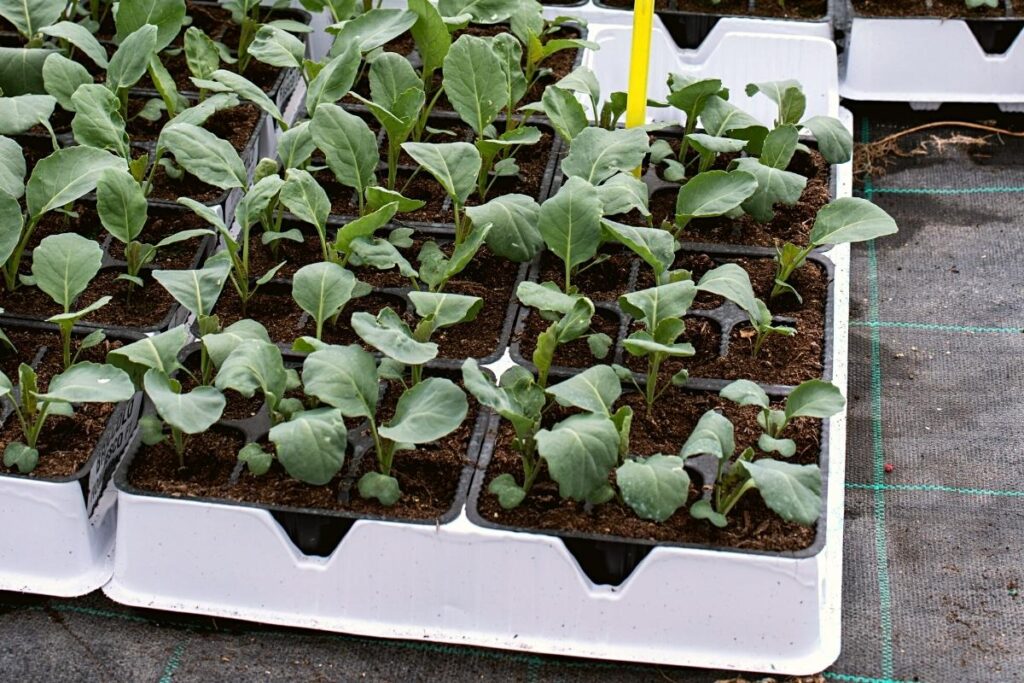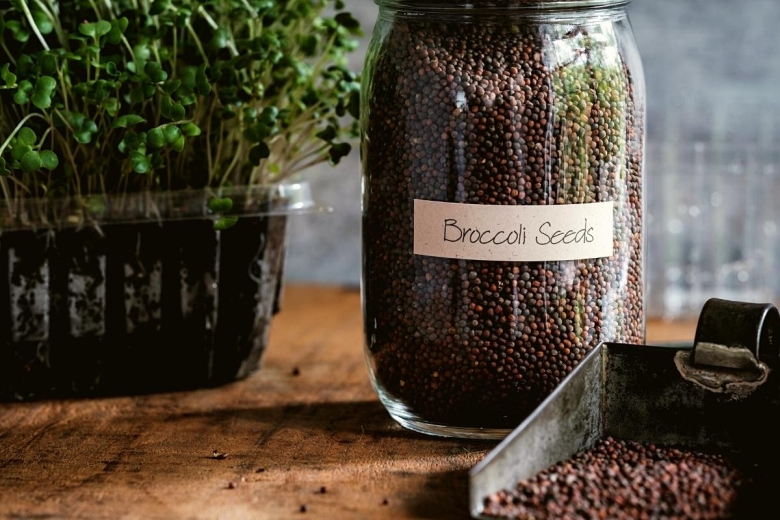
Growing broccoli in containers is becoming more and more popular for people with limited garden space. Broccoli comes from the brassicaceae family which includes cauliflower, cabbage, and Brussel sprouts. The Romans first cultivated broccoli more than 2000 years ago. These Roman farmers referred to this cruciferous vegetable as ‘the five green fingers of Jupiter’.
Growing vegetables such as broccoli in containers is a great way to grow veg if your soil is particularly poor in quality and nutrients. By mixing you own potting mix with appropriate fertilisers, you can successfully grow broccoli in containers across the seasons.
Broccoli is a cool-weather vegetable, preferring to grow out of the summer months. If planted in summer, the broccoli may get too hot and bolt, meaning it will flower and become inedible. The best times to plant broccoli in containers is spring and autumn, shortly before the last or first frost respectively.
Broccoli can be grown in containers from seeds or from nursery starts. If grown from seed, the plant can either be kept indoors during its initial germination and growth period. Hardening the plants by placing them outside for 1-2 hours a day can prepare the plant well for being transplanted to containers. Seeds can also be planted directly into containers outside. Nursery starts are simply planted in containers immediately.
Most Common Questions Asked about Growing Broccoli in Containers
We got your emails! Here are the answers to the 6 most asked questions we received.
Does broccoli grow well in containers?
The short answer to this question is yes! By planting broccoli in containers you can save space in your garden as it can spread out by 3-4ft (0.91-1.22m). Each broccoli sapling or seed planted does need to be spread out in containers to avoid overcrowding, therefore resulting in smaller plants.
Temperatures need to be carefully paid attention to when growing broccoli in containers. Planting broccoli in darker containers can cause too much heat to be absorbed which will bolt the broccoli, or cause it to dry out.
Broccoli grown in containers also needs regular fertilisation with nitrogen-rich fertilisers, and plenty of water.
Growing broccoli in containers gives you greater control over the environment the broccoli is in. As the weather changes, the pots can simply be moved to sunnier or shadier spaces. Growing broccoli in containers also means there are fewer bugs during fall.
Broccoli can be planted in containers either as seeds or nursery transplants. If planting as seeds, it is best to germinate them indoors and gradually harden for a couple of hours a day outdoors. Planting out is recommended when each broccoli plant has 2-3 sets of true leaves and stands at around 4-6 inches (10-15cm) tall.
What is needed to grow broccoli in containers?
A little preparation is needed to successfully grow broccoli in containers. Choosing the correct soil, appropriate drainage material, fertiliser, and of course container are all important in ensuring your crop grows well.
Firstly, containers for growing broccoli should be lighter in colour. Dark coloured containers and black containers should be avoided as they absorb sunlight and will cause the soil and plant to heat up too much. Excessive heat can cause broccoli to bolt leaving it inedible. Lighter coloured pots or lined wooden containers such as trugs are a great way to grow broccoli successfully.
Secondly, choose your soil carefully. Regular potting mix for vegetables can be used with success, however it is best to create a blend of your own for the greatest yield from your plants. A 50-50 mixture of well-draining garden soil combined with compost or well-rotted manure will start the plants off well as the soil will have plenty of nutrients in. If the soil is loose and well-draining it will promote healthy growth.
It is advisable to regularly fertilise the soil, once a month should suffice, with nitrogen-rich fertiliser. If you have previously grown broccoli or any other cruciferous vegetable the soil should be changed. Pests can survive in the soil even after the plants have been removed, so fresh soil will protect your newest crop. Broccoli grows well in 6.0-7.0pH soil which is comfortably in the neutral range. Testing your pH can help adjust fertiliser levels.

What size container do I need to grow broccoli?
When growing broccoli in containers it is important to select the right size to promote healthy growth. Broccoli grows well with one plant per 5 gallon (19L) containers. It is possible to plant up to 3 broccoli in a 15 gallon (57L) container with success. It is important to remember that broccoli needs space for its leaves, and to continue producing florets after the main head has been cut.
As a minimum, containers should be 12 inches (30.48cm) deep to allow the roots plenty of room to grow.
Containers should be light in colour, with plastic being an ideal medium. Terracotta is also a good choice, however moisture levels need to be monitored as terracotta can cause the soil to dry out too quickly.
The most important thing to remember when growing broccoli in containers is that the containers must have drainage holes. Without drainage holes the soil can become waterlogged and can cause root rot, which will kill the plant. To further promote healthy drainage a base layer of gravel or broken pottery can be added. This allows the water to drain down and away from the roots.
Does broccoli grow better in sun or shade?
Broccoli is a cool-weather vegetable and is best planted in late summer or autumn to have a crop lasting through the winter, or in early spring, to avoid the hottest parts of the year.
It is best to plant broccoli in the shade as it requires less direct sunlight than other similar sized vegetables. Depending on the size of your container, position the broccoli in partial shade with the container in full shade to prevent bolting. If your containers are small enough, they can be positioned and moved as required.
Broccoli should ideally receive 6-8 hours of indirect sunlight per day to grow healthily.
In hotter areas or during hotter weather, aim to grow broccoli during spring or fall. If the temperature gets too hot, a protective layer of light-coloured mulch can be added to the top layer of soil to encourage cooler root temperatures.
Broccoli grown in containers should be watered more regularly than if planted in the ground. The soil should be kept moist and if it is too dry, increase your watering schedule. If it has rained recently, avoid watering as frequently as the water can remain in the pots for longer, particularly if they have been in full shade.
What pests effect broccoli grown in containers?
Like all plants, regardless of growing indoors or outdoors, in the ground or in containers, broccoli is susceptible to pests.
Pests such as cabbage loopers, flea beetles, whiteflies, cabbage worms, aphids, and army worms can all cause problems for your crop.
If you are planting up more than one container of broccoli space them 2-3ft (0.5-1m) apart to prevent the spread of infestation should one plant become targeted.
If cutworms are present, the heads of the broccoli can be wrapped in a wax paper cone to prevent further damage. Caterpillars and butterflies can also be stopped by using netting to protect the plants.
Adding diatomaceous earth to the soil can help get rid of unwanted pests.
Will broccoli grow back after cutting?
Broccoli is grown as an annual, so will need to be replaced with new seeds or nursery plants following the growing season. It can however produce more florets after the initial growing and harvesting period if done correctly.
When each broccoli plant produces its first head it should be monitored daily as it can grow very quickly. It is crucial not to let the buds flower as this will render the plant inedible. A full head of broccoli can appear in 4-7 days, reaching a size of 3-5 inches (7-12cm) in diameter. It is now ready to harvest.
When harvesting the first head of broccoli, cut the stem diagonally approximately 4-6 inches (10-15cm) down. This cut will allow the plant to focus growing energy on its side shoots. If done accurately the broccoli plant will continue to grow side shoots and produce florets as long as the weather remains cool.
At the end of the season, remove the plant from the soil and replace with fresh soil ready for the next growing cycle.

Summary
Growing broccoli in containers is easy and a great way to get into vegetable gardening. If you have a limited outdoor space, container farming is an excellent way to begin growing your own produce and if done correctly can lead to fresh fruits, vegetables, and herbs throughout the season.
Broccoli in containers does require a little more attention and care than when planted in the ground. It can become too hot, too dry, or infested by pests more quickly than when planted in the ground. There are simple steps to avoid these issues however, such as regular watering schedules, selecting the correct container, and being aware of common cruciferous vegetable pests in your area.
If you have a sizeable garden and primarily plant in the ground, growing broccoli in containers is a great way to maximise space and free up much needed vegetable bed space for plants that are less fussy when it comes to sun and shade.
Growing broccoli in containers can be very successful when harvest time comes. After removing the main head, further florets and heads are encouraged to grow from side-shoots as the plants main growing energy is diverted.
At the end of the growing season, be sure to change your soil over as any soil planted with cruciferous vegetables such as broccoli can harbour pests that can kill off your next crop.
Growing broccoli in containers is also a great way of encouraging children to get involved with gardening. Let them select their own brightly coloured container, or grab some paints and decorate your own. They can support their little broccoli all the way from seed to the dinner table. It can also be an encouraging way to make them eat their greens!
Italian farmers first planted broccoli 2000 years ago, and with a little care and know-how, we can keep this ancient yet tasty green growing happily in containers at home.
